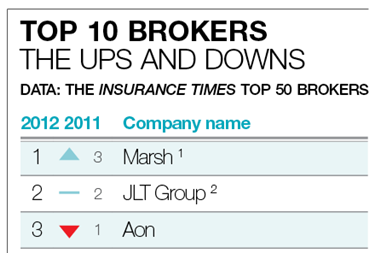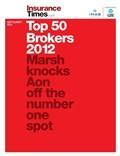From this year’s number one, Marsh, to a new entry to the top 10, Ageas Retail
Marsh | JLT | Aon | Willis | Saga/AA | Towergate | BGL Group | Swinton | Cooper Gay Swett & Crawford | Ageas Retail
1st Marsh
Management: Marsh has been catapulted to the top of the 2012 Top 50 Brokers league from third place last year, smashing Aon’s six-year stranglehold on the number one spot. The coup comes on the back of Marsh growing its UK income by 12.3% in 2011. For Mark Weil, who joined as UK and Ireland chief executive in June this year, the big challenge will be maintaining pole position. As an insurance industry outsider, perhaps he has fewer advantages than some of his rival chiefs in the sector.
But Weil does have pedigree. A former member of the UK special forces, he joins from Marsh’s sister company, management consultancy Oliver Wyman, where he headed financial services in Europe, the Middle East and Africa. Weil replaces Martin South, who has been made chief executive of Marsh Europe. The broker’s parent, Marsh & McLennan companies, has also performed well. In 2011 global revenue increased 9% to $11.5bn (£7.4bn) and after-tax profit was $993m compared with $855m in 2010. Global insurance services revenue totalled $6.3bn, an increase of 9% on the previous year.
Strategy: The US-based broker is thought to be poised to follow Aon in moving its headquarters to London to benefit from the UK’s favourable tax regime for global insurers. Marsh has refused to confirm this. In the meantime, Marsh has been streamlining its business. In June it sold four key portfolios of its Gibbs Hartley Cooper (GHC) wholesale business to rival broker RK Harrison. Marsh is refocusing GHC on providing wholesale services to third parties and Marsh’s UK businesses.
Expertise: The London market broker operates in major insurance hubs worldwide, including Bermuda, Brazil and Singapore. It provides a comprehensive line-up of insurance and risk services - from political risk cover to trade credit - to businesses in a wide range of industries, including energy, entertainment, finance, media, sports and transport.
Big story: The broker has put forward a plan for UK flood insurance to replace the current Statement of Principles agreement between the ABI and government, which expires in June 2013. Project Noah would involve flood risks being pooled and reinsured. The ABI has also tabled a proposal, but the Department for Environment, Food and Rural Affairs has yet to decide on the replacement.
2nd JLT
Management: As chief executive Dominic Burke steers steadily through his seventh year in the post, Jardine Lloyd Thompson has maintained second place in the rankings, which it achieved last year, up from fourth in 2010.
The group continues to grow. Total revenues for 2011 were up 10% to £818.8m from £746.3m in 2010, while profit before tax rose 13% to £134.5m (2010: £119.4m. The first half of 2012 was also strong. Profits rose to £59.3m from £53.6m in the first half of 2011, and revenue climbed 7% to £441.7m, up from £411.3m.
Strategy: In contrast to many of its rivals, JLT’s expansion has been organic and achieved without contingent commissions, which the firm does not accept. Instead it focuses on specialisms such as engineering and sciences, and profits well from risk management advice, rather than competing on price alone.
Burke believes there is no great need for JLT to expand through mergers and has vowed never to make transformational acquisitions. Instead, JLT is planning small bolt-on buys, funded from a £150m war chest, to expand its new Specialty division in the regions. The division opened offices in Nottingham and Reading this year and plans more, adding to existing locations in Birmingham, Leeds, London, Manchester and Southampton.
JLT’s managing general agency business, Thistle Insurance Services, continues to disappoint both managers and analysts. In May last year JLT made Thistle chief executive James Gerry redundant, citing duplication in senior roles. It appointed his permanent replacement, former Footman James boss Paul Matthews, in July.
Expertise: JLT’s three main business units are risk and insurance, employee benefits and Thistle Insurance Services. The group operates in 135 countries.
Big story: In February, JLT Specialty unveiled its JLT Speciality Risk Practice, which was formed in November 2011 when the UK regional broking arm and London-based global risks business merged. The unit is designed to draw JLT away from lower-end commoditised business and up the value chain into more profitable corporate niches. In the resulting shake-up, several managers left JLT’s Global Risk Solutions: managing director Ron Hayes; head of placement and servicing Chris Tabbitt; and head of sales Warren Dann.
3rd Aon
Management: Aon’s demotion to third place in this year’s Top 50 ends a number one ranking that began in 2006. Yet its slump in the rankings, based on UK income, coincides with the broker moving its global headquarters to London. From his office in one of London’s newest skyscrapers, 122 Leadenhall Street, UK chief executive Robert Brown will no doubt be plotting his firm’s route back to the top.
Strategy: Since Aon’s last major UK acquisition was back in 2008, when it bought Benfield Group - then the world’s third largest reinsurance broker - a large merger might be one path to restoring the broker’s fortunes. Despite the slip in its UK ranking, the global Aon group has expanded. It increased after-tax profit 39% to $979m (£625m) in 2011, compared with $706m in 2010. Turnover also rose 33% to $11.3bn, thanks to commissions rising by one-third.
However, during the first half of 2012 after-tax profits dropped 4% as revenues from commissions and fees remained flat. Aon’s most recent acquisition was the corporate broking business of Dutch bank ABN AMRO in April.
Expertise: Aon operates in more than 120 countries and offers the full range of insurance and risk management services to companies and individuals.
Big story: Aon’s board of directors authorised a surprisingly large share repurchase programme of $5bn in April. This was accompanied by the first dividend rise in a decade, a
5% increase in the annual cash dividend paid quarterly on class A shares.
The buy-back, if used, would slash Aon’s shares in circulation and could potentially boost value for remaining shareholders, as well as the personal wealth of directors. For four Aon board members relocating to the UK, this comes on top of a shared $6.5m compensation deal.
The buy-back may have been a result of tax savings resulting from the move to London, but the funds could have been invested in a growth-boosting acquisition.
4th Willis
Management: Willis was hit by the unexpected departure of UK chief executive Brendan McManus in October 2011. His replacement, Dan Wilkinson, faced a battle to improve morale after several other blows in 2011. These include a record fine from the FSA for not having proper anti-bribery and corruption controls in place, the departure of international boss David Margrett and the retirement of group president Grahame Millwater after a quarter of a century with the firm, and revelations of surging director pay amid a general staff wage freeze.
Strategy: This said, Willis’s results for the first quarter of 2012, with Wilkinson at the helm in the UK, beat analyst expectations. Net profit surged to $225m (£140m) in the first quarter compared with $35m in the same period last year. However, revenues for the quarter were $1.01bn compared with $1.007bn for the same period last year, an increase of 1%, and the group’s commissions and fees remained static at about $1bn.
Willis is particularly weak in the UK, where it has seen a mid-single digit decline in commissions and fees. Understandably, group chief executive Joe Plumeri is looking for growth. Wilkinson appears to be on course to deliver it in the UK by emphasising sales and containing costs.
Big story: Willis launched its own global placement system to rival Aon’s Global Risk Insight Platform (GRIP) in December. It hopes 70% of premiums will go through the system, although it is something of a latecomer compared with the four-year-old GRIP.
5th Saga / Automobile Association
Management: Andrew Goodsell led a management buy-out in 2007 at broker Saga, funded by private equity firm Charterhouse, which also bought AA Insurance and merged it with Saga to create Acromas. The private equity house remains the majority shareholder in Acromas and Goodsell its chief executive.
But things are not going to plan. Acromas remains highly leveraged and there is scant evidence of any benefits accruing from the merger of the automobile and over-50s brokerages. Interest payments outweigh profits and Acromas reported an after-tax loss of £512.1m in the year to 31 January 2011, with a shareholder’s deficit increase of 25% to £2.2bn.
Strategy: With Acromas just one of three loss-making brokerages on Charterhouse’s hands - along with Giles and Drive Assist - the next step, in line with standard private equity practice, could be to float Acromas. It is understood that an IPO is being considered for this year. Whether Acromas would list as two separate entities is unclear, though there would be logic in this.
However, stock market investors have become wary of private equity houses ridding themselves of debt-laden companies in this way, so a flotation is unlikely to be straightforward.
Big story: Charterhouse was rumoured to be using Acromas and Giles to buy Groupama’s UK businesses. However, the insurer’s French parent company continues to delay over selling its UK brokers.
6th The Towergate Partnership
Management: The revolving door has been spinning at Towergate since founding duo Peter Cullum and Andy Homer stepped back to non-executive positions. High-profile moves include the appointment of former Aviva UK boss Mark Hodges as chief executive in September 2011. Two long-serving directors quit in June: Jonathan Walker, whom Hodges had placed in the role of integration director - critical at the consolidator - and Tim Philip, finance director.
In May it emerged that Alan McEwan, who was running UK retail acquisitions, had defected to Giles to run Scotland and Northern Ireland. Broker Network director Bernard Mageean also joined Giles as managing director of underwriting and wholesale. However, Towergate has itself made a number of appointments as Hodges gets his top team in order. The biggest recruitment was Scott Egan, who left Brit to join Towergate as finance director.
Strategy: Hodges has been leading the fight-back with a string of key appointments, including former Brit chief financial officer Scott Egan as new group CFO, but the pair have their work cut out. On the plus side, first-quarter results in May showed operating earnings rose 9% to £34.3m and revenues increased 2% to £105.5m, while Towergate’s highest paid director’s pay packet rocketed 186% to £2.4m, from £846,742.
However, the core retail business looks less healthy. Operating earnings dropped 8% to £15.6m and revenues dipped 4% to £60.5m. Also, the firm has close to £1bn of debt on its books. Hodges plans to turn it around by growing specialist business and acquisitions.
Towergate has remained sixth in the Top 50 this year despite the inclusion of Callum Capital Ventures in its figures, which was previously treated as a separate entry.
Big story: Towergate racked up its twelfth and thirteenth deals for this year in July. It bought the non-life division of Hampshire-based Sheraton Insurance Brokers and Berkshire-based military, travel, landlord and expatriate insurance specialist JBI International Insurance Brokers.
7th BGL Group
Management: The personal lines broker and aggregator has held steady in last year’s ranking position under Peter Winslow, who has led BGL Group since 1995.
However, there has been some management turnover in the past year. David Downie joined from HSS Hire Group to take on the new role of group director of intermediated businesses. And Mark Townsend was drafted in to report to Downie as managing director of Frontline, the unit responsible for the company’s own-branded products, including Budget and Dial Direct.
Townsend replaces Andy Bord, who left BGL at the end of 2011. Founder Douw Steyn also stepped down as non-executive chairman, although this was not a strategic development and he will not be replaced.
Strategy: The Russian meerkats that advertise BGL’s Comparethemarket aggregator continue to pay off. The website was the main force behind a profit rise in the group’s last reported results for the year to 30 June 2011. Pre-tax profit was £72m, up 15.5% on the previous year’s £62.3m, on revenues of £361.2m, up 19.5% on £302.2m for 2009/10.
Big story: BGL has launched two key products in recent months. In July it unveiled Beagle Street, which offers customers life insurance cover as soon as they buy, with no need for medicals. Meanwhile, an innovative anti-fraud system inaugurated in May uses a database to validate customer information at the point of quote.
8th Swinton Group
Management: After the shock sacking of Swinton’s entire executive board in December, French parent Covea appointed Christophe Bardet to replace chief executive Peter Halpin
in January.
The appointment of Bardet, a French national with more than a decade at Covea subsidiary MMA Holdings under his belt, spent mostly in France, is designed to bring Swinton’s management closer to headquarters. The mass sacking followed a dispute over the board’s performance-related share scheme payments due to be made in the first quarter of 2012.
Strategy: Covea UK, Swinton’s parent, has pulled the plug on plans to launch an aggregator, leaving Bardet time to focus on keeping basic operations on track as the business recovers from its management hit. The good news for Bardet is that at least Swinton’s accounts appear to be in good shape. Profits rose 22% to £34.3m in 2011 (2010: £28.1m) and turnover was up 18% at £329m, thanks to acquisitions, online sales and product launches.
Big story: The major Swinton story remains the fallout from the sackings - especially shocking at a traditionally solid personal lines broker with a huge high street presence. In July Bardet told Insurance Times that chief financial officer Charles Bellringer had left the company and been replaced by former Provident finance boss Christian Charles Plumer. Bardet will hold a strategic review in September.
9th Cooper Gay Swett & Crawford
Management: Cooper Gay Swett & Crawford (CGSC) has been expanding organically and through acquisition under group chief executive Toby Esser. The group’s Lloyd’s and London market broking operation, Cooper Gay & Co, returned to profit in 2011 under then chief executive Shaun Hooper.
Hooper was rewarded in April 2012 with a promotion to group-level chief commercial officer. He was replaced by Cooper Gay & Co chief financial officer Sam Hovey.
Strategy: CGSC as a whole returned to a profit of $1.7m (£1.1m) in 2011 from a loss of $24.5m in 2010 - the year Cooper Gay Holdings merged with US wholesaler Swett & Crawford to form the group. The improvement came despite headwinds such as the tough economic environment, higher costs from investing in
the business and continued work to integrate the group.
Cooper Gay & Co, described as “the trading fulcrum of the group”, made a £4.5m profit after tax in 2011 compared with 2010’s £381,000 loss. This was thanks to higher turnover, lower costs and a smaller tax bill, and was achieved despite tough conditions and persistently soft rates.
Big story: In an interview with Insurance Times, Esser said CGSC’s planned IPO had been put on ice because of poor capital market conditions. The group is looking to private equity to fund further growth, and in July private equity firm Lightyear Capital emerged as the front runner to buy a stake in the broking group.
10th Ageas Retail
Management: Ageas Retail is up from a combined 12th spot in last year’s league because it has begun reporting all three retail broking business units - Ageas Insurance Solution (AIS), Kwik-Fit, RIAS - as one for the first time. The broking group continues to hold its own in tough market conditions, under the direction of Ageas UK retail managing director Andy Watson and Ageas UK group chief executive Barry Smith. It also continues to acquire: over 50s broker Castle Cover became part of the Ageas Retail family in March 2011. Ageas Retail reported a £16.5m profit in the first half of 2012.
Watson has run the UK retail business since February 2010, having previously been in charge of HSBC Insurance’s UK business. He is supported by RIAS and Castle Cover managing director Peter Corfield, who took over from Janet Connor in January 2012, AIS managing director Jason Banwell, retail commercial director Brendan Devine, and Kwik-Fit Financial Services managing director June Lynch.
In June, AIS hired Colin Butler as senior insurer development manager and Chris Quayle as head of finance.
Strategy: While Ageas Retail was firmly in profitable territory at the half-year 2012 stage, profit was 8% down on the £18m it reported in the first half of 2011. Revenues were flat at £105m (H1 2011: £106m).
However, the decline came amid increasing competition for a dwindling pot of insurance business. Ageas described the retail broking division’s first-half performance as “a resilient performance in tough trading conditions”.
Big story: Smith came out in support of the government’s controversial plan for a flood levy in July, though he said more work needed to be done on the idea. The plan was attacked by others, including Brokerbility chairman Ashwin Mistry, who branded the idea a “stealth tax” in an interview with the Daily Telegraph.
Hosted by comedian and actor Tom Allen, 34 Gold, 23 Silver and 22 Bronze awards were handed out across an amazing 34 categories recognising brilliance and innovation right across the breadth of UK general insurance.














































No comments yet